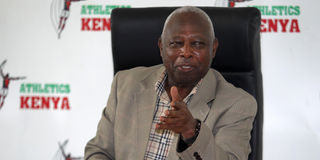Athletics Kenya joins UNEP, WHO in fight against air pollution

Athletics Kenya President Jackson Tuwei gestures during a press conference at Riadha House on December 15, 2021.
What you need to know:
- Athletics Kenya President Lieutenant General (Rtd) Jackson Tuwei says AK has already drawn a strategy to address pollution and climate change.
- One of the critical issues to be addressed is how climate change and air pollution have affected the sporting environment.
Concerned by the state of changing environment that is already affecting the sport, Athletics Kenya has joined environmentalists and policy makers in addressing the problem of air pollution.
Athletics Kenya President Lieutenant General (Rtd) Jackson Tuwei says AK has already drawn a strategy to address pollution and climate change.
One of the critical issues to be addressed is how climate change and air pollution have affected the sporting environment.
The athletics umbrella body is doing it in conformity with the United Nations Framework Convention on Climate Change, which has come up with the Sports for Climate Action Framework as the strategy to address sporting activities and climate effects.
“Over the last few decades, the athletics world has been experiencing side effects of global warming which in turn is affecting the weather patterns in different parts of the country as well as the world. The increasing hot temperatures affect the sport because athletes biologically perform optimally within a certain environment,” said Tuwei.
“If there is a rise in temperatures, it can only mean, either to postpone until the right temperatures recommended for a given sport is realised or to move it to another location. Any above decisions will mean re-strategising, and if that were to be done every time there was a world sporting event, then you can read where the mark is going about sports budgets in future.”
Besides rising temperatures, athletes are prone to lung infections if they happen to be racing within an area whose ambient air (open ground-air) is polluted.
This lowers their mobility (kinesis) as they are not able to breathe freely, something that affects their end performance.
To a great extent, air quality is interlinked with environmental and forestry destruction, alongside changing weather patterns within highlands where athletes have long been known to practise to optimise their stardom internationally.
“Some of you who followed the 2021 Olympics Games in Tokyo may recall that even as we celebrated the endurance and resilience of our athletes Peres Jepchirchir and Brigid Kosgei, who dominated the women’s marathon and brought glory and honour to Kenya by bagging gold and silver medals, they had to endure unusually high temperatures in Sapporo that even forced the organisers to change the start time of the race. Other adverse weather conditions were witnessed during the World Championships in 2019 and Beijing Olympics in 2008,” explains Tuwei.
It is due to this concern that different players drawn from environmental, health and policy sectors have been meeting to deliberate on the way forward.
“Clean air is very important to a runner. As you run, you need to exhale used air and for the lungs to get in fresher air so as to facilitate the running activity. It comes as no surprise that all around us we are witnessing deteriorating air quality due to an increase in air pollution, which is made worse by the impacts of climate change,” added Tuwei.
During a meeting held in Nairobi to address air pollution and its effect on athletics, that brought together UNEP, WHO, Stockholm Environment Institute (SEI) – Africa Centre and the Nairobi Metropolitan Services, a concern was raised on the risk that morning joggers could be exposing themselves to during heavy traffic as people rush to work.
“The carbon emission cumulatively by heavy traffic in the morning as people rush to work gets to be concentrated within one area and particularly along the roads where people jog. This happens because, in the morning, the air is usually still with little or no breeze to whirl it,” explains Dr Njogu Mbarua, an expert on climate and environment with Joint Environment and Climate Action, a non-governmental organisation.
“Precipitation is not enough to keep our ambient air clean and going. We must devise actionable ways, policy and regulatory, of ensuring that the air we are breathing and our children are going to be breathing is well within the international safety standards. As we get concerned with protecting children who are already born, we must bear similar concern for the unborn children as research is indicating of a possibility of mother-to-foetus air pollution transmission,” said Dr Andriannah Mbandi, an air quality researcher and UNEP Technical Coordinator, Regional Office for Africa.
The meeting recommended more studies to be conducted to ascertain the level of pollution in various parts of cities and towns.



